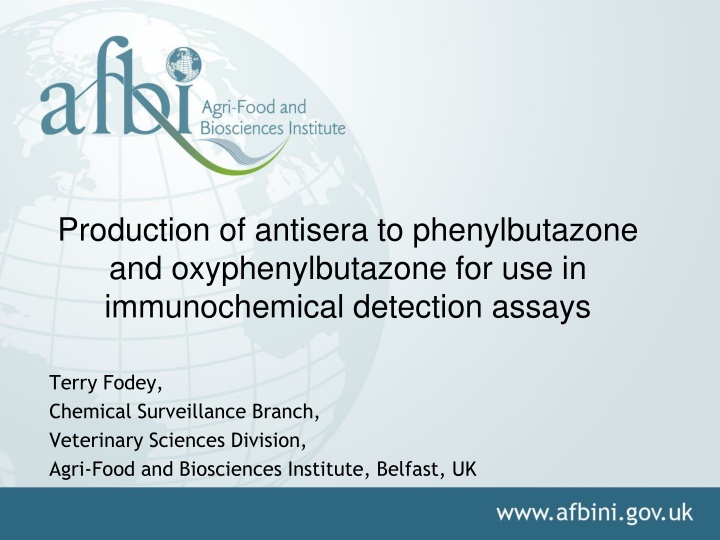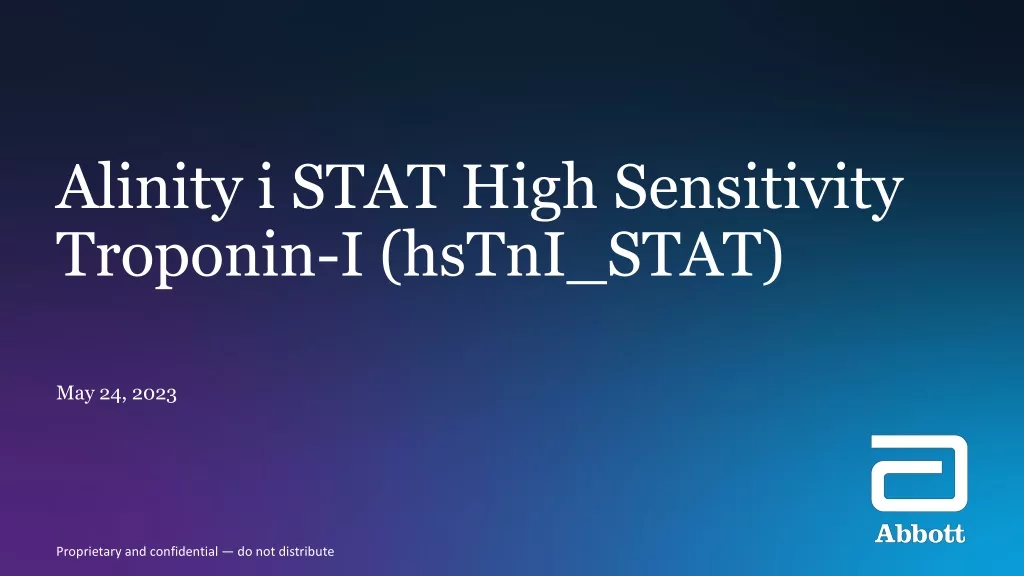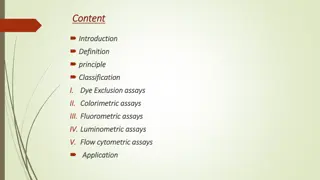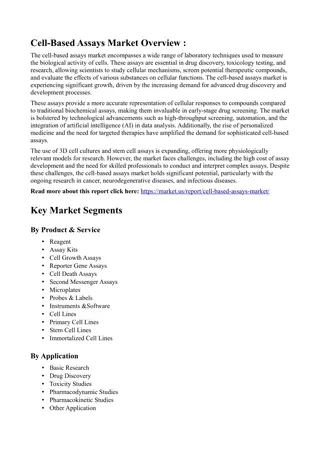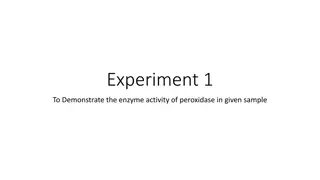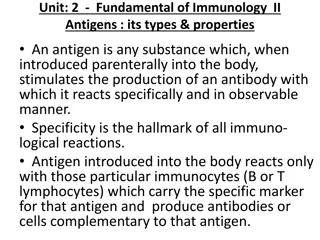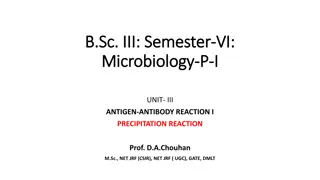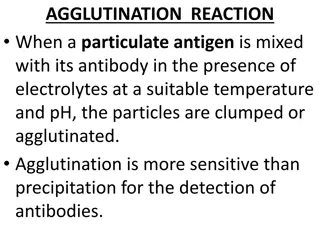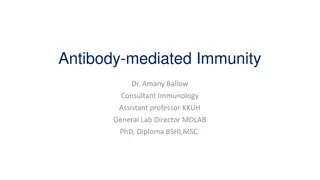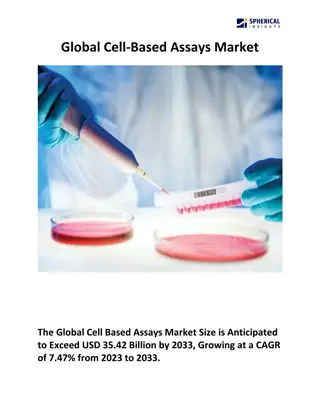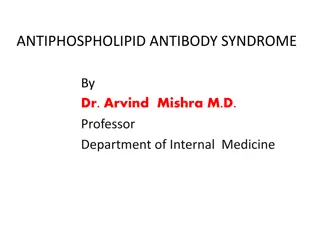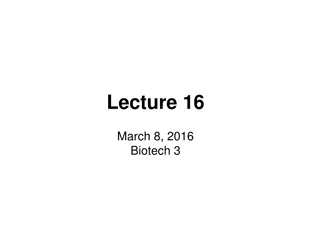Antibody Production for Phenylbutazone and Oxyphenylbutazone Detection Assays in Veterinary Sciences
Terry Fodey, from the Veterinary Sciences Division in the UK, focuses on producing antisera for phenylbutazone and oxyphenylbutazone to use in immunochemical detection assays. The presentation covers the importance of antibodies, approaches to production, and performance comparison. Phenylbutazone, a non-steroidal anti-inflammatory drug, initially used in human medicine, is now commonly used in equines due to its efficacy but is not permitted for food-producing animals due to health risks.
Download Presentation

Please find below an Image/Link to download the presentation.
The content on the website is provided AS IS for your information and personal use only. It may not be sold, licensed, or shared on other websites without obtaining consent from the author.If you encounter any issues during the download, it is possible that the publisher has removed the file from their server.
You are allowed to download the files provided on this website for personal or commercial use, subject to the condition that they are used lawfully. All files are the property of their respective owners.
The content on the website is provided AS IS for your information and personal use only. It may not be sold, licensed, or shared on other websites without obtaining consent from the author.
E N D
Presentation Transcript
Production of antisera to phenylbutazone and oxyphenylbutazone for use in immunochemical detection assays Terry Fodey, Chemical Surveillance Branch, Veterinary Sciences Division, Agri-Food and Biosciences Institute, Belfast, UK
https://upload.wikimedia.org/wikipedia/commons/4/4f/Uk_map.pnghttps://upload.wikimedia.org/wikipedia/commons/4/4f/Uk_map.png AFBI Location and Work Areas Animal Health and Welfare Crops and Grassland Economics and Rural Development Environment and Land-use Fisheries and Aquatic Ecosystems Food Livestock
AFBI Stormont, Veterinary Sciences Division Virology Bacteriology Disease Surveillance and Investigation Chemical Surveillance National Reference Laboratory for veterinary drug residue control Immunological screening assays - antibody production Microbiological and TLC screening assays Chromatography and mass spectroscopy chemical confirmation methods Monitoring chemical residues in meat, milk, eggs and shellfish
Scope of presentation What is Phenylbutazone? Why do we need an antibody to it? Approaches to antibody production Comparison of antisera performance Conclusions
What is Phenylbutazone? O N N CH3 O A non-steroidal anti-inflammatory drug (NSAID) Abbreviated to PBZ; often called Bute Introduced to human medicine in 1949 for the treatment of rheumatoid and arthritic disorders Found to induce disorders of the blood including aplastic anaemia, leukopenia, granulocytosis and thrombocytopenia, in some cases leading to death Consequently, its use in human medicine became limited with the licence for use in man revoked in the U.K. in 1984
Use in horses Choice of NSAID for equines since its introduction to veterinary medicine in the 1950s Substantial clinical history of efficacy and safety in horses accumulated over both short and long treatment periods Horse meat is consumed in many countries The CVMP assessed PBZ in 1997: Health risks are blood dyscrasias and the genotoxic & carcinogenic potential No thresholds identified so maximum residue limits could not be established Therefore PBZ is not permitted for use in any food producing animals
Eu protocols to prevent PBZ treated horses entering food chain Since 2005 horses must have a passport for identification Must be signed to declare if the animal is intended for human consumption However PBZ prescribed without checking passport Subsequent failure to sign out of food chain after prescription Horses change owners with passport not signed to exclude from food chain Medicated meal for one horse may be consumed by another animal (VMD) VMD (Veterinary Medicines Directorate) http://aka-vmd.defra.gov.uk/VRC/pdf/PositionPaper_Phenylbutazone.pdf
PBZ detection in Eu From 2008-2012, 5.4% of equines tested were non-compliant From 2008-2012, 0.3% of bovines tested were non-compliant
European Commission Press Release Brussels, 12 September 2014
European Commission Press Release Brussels, 12 September 2014 Main elements With nearly 7 million equidae in Europe, the revised rules will require foals to be issued with a single passport having a unique identification number, before their first birthday. The passport also serves as a medical record and will serve the horse over its lifetime. All horses born after 1 July 2009 will need to be micro-chipped. Technical security features aimed at reducing the risk of falsified passports have also been put in place. The introduction of a compulsory centralised database in all Member States will assist the competent authorities to better control the issuance of the passports by different passport issuing bodies. It will also substantially simplify, for the keepers, the procedures for updating the identification data in both the passport and the database of the issuing bodies. Next steps The Regulation will apply from 1 January 2016. However, EU countries not already having a centralised database will have until 1 July 2016 to put one in place.
Residue sources Feeding vessels can be contaminated Untreated animals can become contaminated from treated ones Fraudulent use of horsemeat as a substitute for beef Uninformed use of drug Illegal use of drug Fodey, T. L., Smyth, W.G., Barnes, P., Traynor, I.M., Kennedy, D.G., Crooks, S.R.H. (2015) Investigation into sources of contamination of cattle with phenylbutazone. Veterinary Record 176(3) 74-76
PBZ detection in Eu From 2008-2012, 5.4% of equines tested were non-compliant From 2008-2012, 0.3% of bovines tested were non-compliant Physicochemical methods of analysis exist Community reference laboratory recommended detection: Substance Matrix Phenylbutazone Oxyphenylbutazone liver, milk, plasma Recommended conc 5 ppb Muscle, kidney,
Metabolites and analogues The principal metabolites are oxyphenylbutazone and - hydroxyphenylbutazone They possess analgesic/anti-inflammatory properties and thus contribute (probably small-moderate degree) to the pharmacological actions of phenylbutazone For both metabolites, urine concentrations are much higher than those in plasma Suxibuzone is a pro-drug of PBZ, designed to reduce gastro- intestinal disturbances. Also banned in food producing animals
Immunogenicity PBZ and its analogues are low molecular weight ranging from 308.4 Da (PBZ) to 428.5 Da (SBZ) They need to be conjugated to large carrier proteins to render them immunogenic
Hapten options for antibody production Phenylbutazone O N N H O CH3 O O N O N N N CH3 CH3 O H O O Oxyphenylbutazone -Hydroxyphenylbutazone O N N CH3 O O O O OH Suxibuzone
Suxibuzone-HSA (step 1) O O O N N N N N N N N CH3 CH3 CDI O O O O O O O O N OH N Carboxylic acid activation via 1,1 -carbonyldiimidazole creates acyl imidazole reactive intermediate
Suxibuzone-HSA (step 2) O O N N N N CH3 CH3 O NH2 O HSA O O O O O O HSA NH N N Acyl imidazole intermediate species reacts with primary amine on carrier to generate stable amide linkage
Oxyphenylbutazone-HSA (step 1) O H O O N O NH N O C O O O N N N CH3 N PMPI O O O N O CH3 Hydroxyl on OPBZ reacted with isocyanate group of N-(p-maleimidophenyl)- isocyanate (PMPI) leaving maleimide group available for reaction O O O O O O Hydroxylamine HSA NH2 HSA HSA N NH SH NH S O S O N-succinimidyl-S-acetylthiopropionate (SATP) reacted with primary amine on carrier to add a sulfhydryl group for reaction
Oxyphenylbutazone-HSA (step 2) O O O HSA S NH O O N N O O NH NH O O O HSA NH SH N N O O N N O O CH3 CH3 Maleimide and sulfhydryl groups brought together to create coupling of hapten to carrier
-Hydroxyphenylbutazone-HSA (step 1) N O O O N O N O N N O N CH3 O O O O O O DSC O O CH3 O H O N O Hydroxyl group on HPBZ is activated with N,N -Disuccinimidyl carbonate to create succinimidyl carbonate intermediate
-Hydroxyphenylbutazone-HSA (step 2) N O N O N N O O O O O O HSA NH2 O O NH N HSA O Succinimidyl carbonate intermediate is reacted with amine on carrier to produce carbamate linkage
Phenylbutazone-HSA (step 1) N HOOC N NH2 HOOC O O N N HNO2 N N CH3 CH3 O O p-Amino benzoic acid is diazotised before adding to PBZ Kawashima, K., R. Dixon and S. Spector (1975) Development of radioimmunoassay for chlorpromazine. European Journal of Pharmacology 32(2)195-202
Phenylbutazone-HSA (step 2) N HOOC O N N N NH HSA NH2 HSA O N EDC/NHS O N N CH3 N O CH3 O The newly formed carboxylic acid is activated by carbodiimde reaction to allow coupling to carrier via amine
Enzyme labels Horseradish peroxidase was conjugated to each hapten by the same method as for the immunogen production Each of the 4 enzyme labels were used for determination of antibody titre in direct competitive ELISA checkerboards for all sera samples This created homologous and heterologous assay formats
Immunisation After conjugation the immunogens were purified and mixed with an adjuvant before administration to the host Two rabbits were immunised for each immunogen http://image.made-in-china.com/2f0j00IHQaTVtnmzLv/Clear-Molded-Vials-for-Injection-7-5MLB-120072-.jpg Immunise host under skin http://www.haoranbio.com/pic/product/2012-07/20120720034123390625.jpg + = Purified immunogen Mineral oil adjuvant Thickened emulsion Re-immunise x 4-6 Remove blood to collect antisera containing specific antibodies
Immunisation First boost after two weeks, then monthly Blood samples taken 10 days after each immunisation were assessed for specific antibodies Number of immunisations ranged from 6 to 8 before a satisfactory titre was obtained
Homologous vs Heterologous The SBZ-HRP enzyme label performed better than the other HRPs in combination with all antisera Therefore for PBZ, OPBZ and HPBZ assays were heterologous while SBZ assay was homologous O O N N N N CH3 CH3 O O H O H O -Hydroxyphenylbutazone Phenylbutazone O N N CH3 O O N O O N CH3 O OH O Suxibuzone Oxyphenylbutazone
Antisera sensitivity and specificity IC50s (ng/ml) [% cross-reactivity] OPBZ Immunogen PBZ HPBZ SBZ PBZ-HSA (1) 18.3 [100] 53.9 [34] >100 [ND] 94.6 [19] PBZ-HSA (2) 5.5 [100] 57.2 ]10] >100 [ND] 5.5 [100] SBZ-HSA (1) 4.6 [198] 89.2 [10] >100 [ND] 9.1 [100] SBZ-HSA (2) 3.6 [39] >100 [ND] >100 [ND] 1.4 [100] OPBZ-HSA (1) 5.8 [97] 5.6 [100] >100 [ND] 2.2 [255] OPBZ-HSA (2) >100 [ND] >100 [ND] >100 [ND] >100 [ND] -HPBZ-HSA (1) 7.7 [165] >100 [ND] 12.7 [100] 7.3 [174] -HPBZ-HSA (2) 0.9 [433] 9.3 [42] 3.9 [100] 3.7 [105] ND = Not determined All data produced using SBZ-HRP in direct competitive ELISAs
Conclusions Antisera to PBZ can be produced from all four haptens with -HPBZ and SBZ providing the best sensitivity The most sensitive antisera to OPBZ are produced from OPBZ hapten Only -HPBZ immunogen produced antisera capable of binding -HPBZ As has been previously established there are significant variations in immune response between hosts O O N N N N CH3 CH3 O O H O H O -Hydroxyphenylbutazone Phenylbutazone O N N CH3 O O N O O N CH3 O OH O Suxibuzone Oxyphenylbutazone
Thanks Colleagues from AFBI: Mr Paul Barnes and Dr. Steven Crooks for their assistance in this study Professors Smith and Eremin for hosting this symposium and providing the opportunity for me to present this work You for your attention
